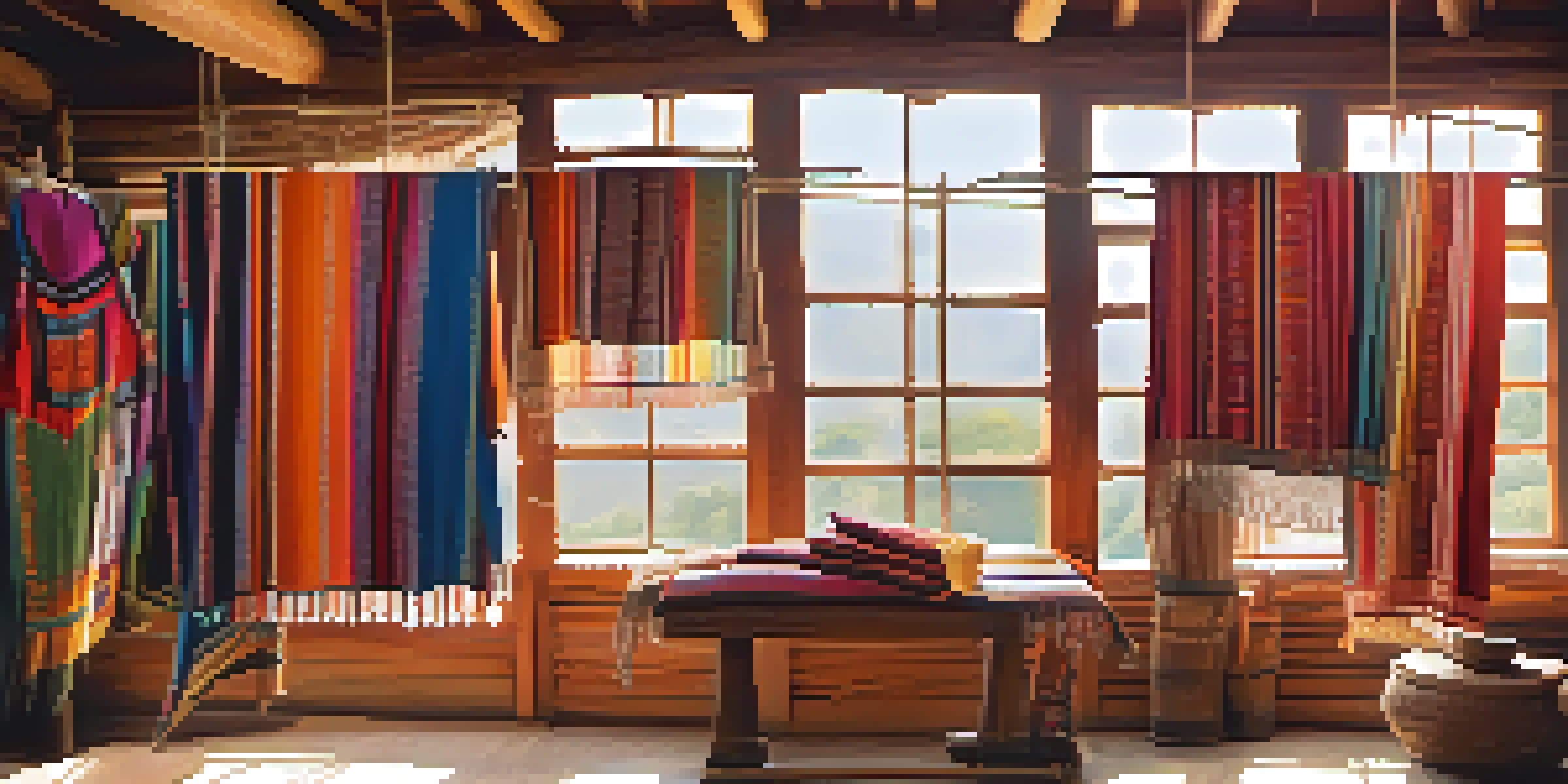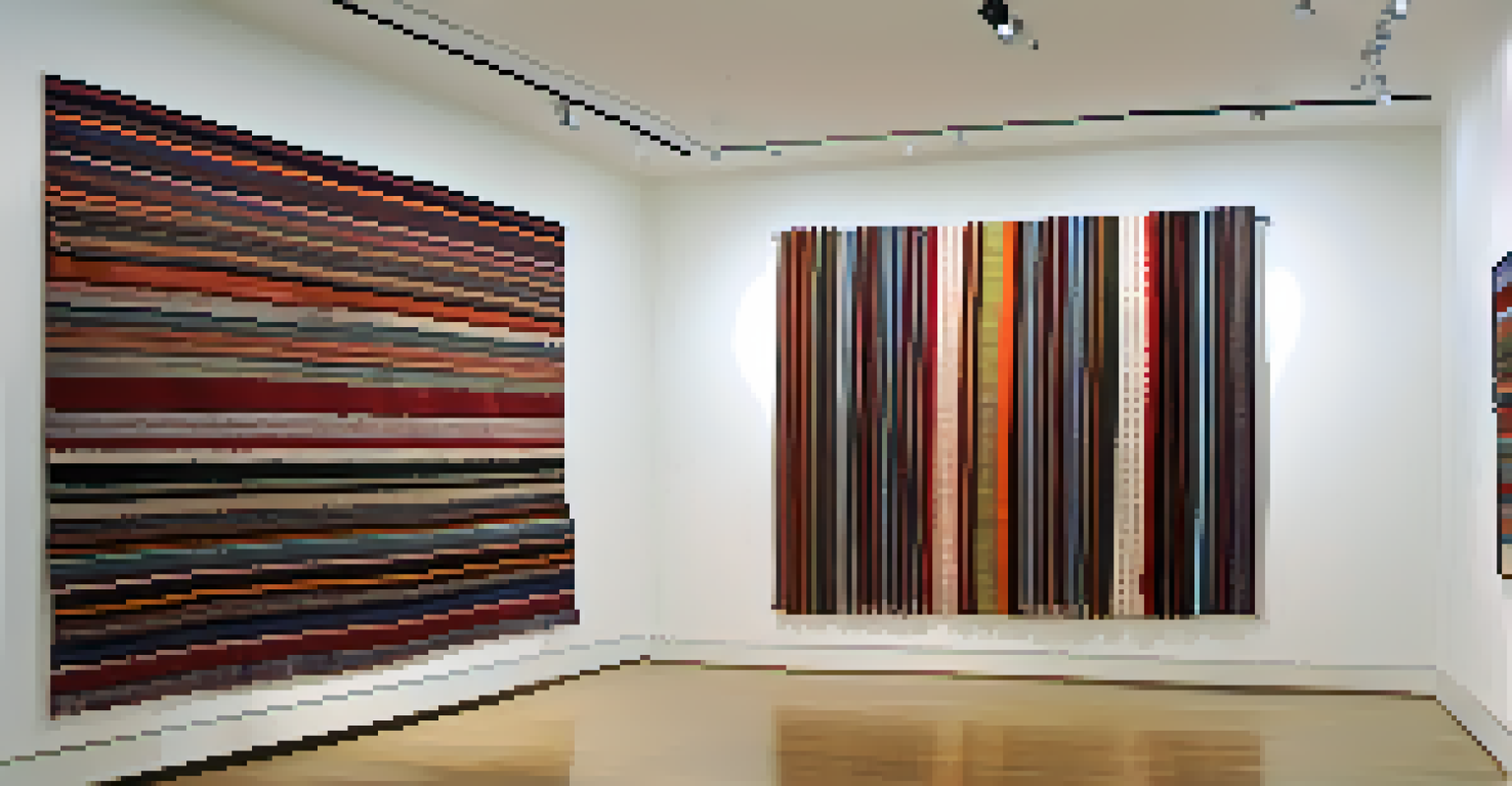The Role of Peruvian Textiles in Contemporary Art Movements

The Rich History of Peruvian Textiles and Their Significance
Peruvian textiles boast a vibrant history that dates back thousands of years, deeply rooted in the traditions of indigenous cultures. Each piece often tells a story, with intricate designs and colors reflecting the natural world and cultural beliefs. These textiles are more than just fabric; they are a medium through which the Peruvian identity is expressed.
Textiles are a means of expressing identity, culture, and history.
Craftsmanship in Peruvian textiles is passed down through generations, making each piece unique. Techniques like weaving and dyeing using natural materials highlight the skills of artisans and their connection to the land. This heritage not only preserves history but also informs contemporary artists who draw inspiration from these age-old practices.
As we explore the role of textiles in contemporary art, it’s essential to understand this rich backdrop. The interplay between history and modern expression creates a fertile ground for innovation, allowing artists to reinterpret traditional motifs in ways that resonate with today’s audience.
Contemporary Artists Embracing Peruvian Textile Techniques
Many contemporary artists are looking to Peruvian textiles for inspiration, integrating traditional techniques into their modern works. For instance, artists like Sandra Ramos and Teresa Burga incorporate weaving methods to explore themes of identity and cultural heritage. This fusion of old and new not only honors the craft but also breathes new life into it.

Using textiles as a medium allows these artists to communicate complex narratives that reflect their personal experiences and societal issues. The tactile nature of fabric can evoke emotions and connect viewers to the artwork on a visceral level. This approach encourages a dialogue between the past and present, highlighting the relevance of traditional techniques.
Heritage in Every Stitch
Peruvian textiles are rich in history and cultural significance, reflecting indigenous traditions through unique craftsmanship.
Through workshops and collaborations, contemporary artists are also giving a platform to indigenous artisans, fostering a sense of community and shared creativity. This collaboration enriches the art scene, demonstrating how traditional methods can coexist with modern artistic practices.
The Global Influence of Peruvian Textiles in Artistic Expressions
Peruvian textiles have transcended borders, influencing artists worldwide. Their vibrant colors and intricate patterns have found their way into various art forms, from painting to installation. This global appreciation highlights the universal appeal of these textiles, as artists adapt them to convey their unique messages.
Art is a powerful tool for storytelling, capable of fostering connections across diverse backgrounds.
Art fairs and exhibitions often showcase works that feature Peruvian textile elements, opening up discussions about cultural appropriation and authenticity. While some artists celebrate the beauty of these textiles, others navigate the fine line between homage and exploitation. This conversation is crucial in understanding the impact of cultural exchange in art.
By examining the global influence of Peruvian textiles, we see how they serve as a bridge between cultures. They remind us that art is a powerful tool for storytelling, capable of fostering connections across diverse backgrounds while also sparking important dialogues about heritage and ownership.
Textiles as a Medium for Social and Political Commentary
In contemporary art, textiles are increasingly recognized as powerful mediums for social and political commentary. Artists use fabric to convey messages about issues such as gender equality, environmental sustainability, and cultural identity. The tactile nature of textiles allows for a nuanced approach to complex themes, engaging viewers in a unique way.
For instance, some artists incorporate recycled materials or traditional textile techniques to address sustainability and the impact of consumerism. By doing so, they not only raise awareness but also challenge viewers to reconsider their relationship with art and the world around them. This blend of aesthetics and activism creates a compelling narrative.
Modern Artists Reviving Tradition
Contemporary artists are integrating traditional Peruvian textile techniques into their work, creating a dialogue between past and present.
As these themes resonate more deeply with audiences, the role of textiles in art continues to evolve. They become a canvas for dialogue, where the act of creation itself becomes a statement about the world we live in, reflecting both personal and collective struggles.
The Role of Technology in Revitalizing Textile Artistry
Technology is playing a significant role in revitalizing the art of textiles, allowing artists to blend traditional methods with modern techniques. Digital printing, for example, enables the reproduction of intricate designs on a scale previously unimaginable. This innovation opens new avenues for creativity while preserving the essence of traditional artistry.
Moreover, online platforms have made it easier for artisans to showcase their work to a global audience. Artists can share their stories and techniques through social media, creating a community of enthusiasts and collectors. This visibility not only honors the craft but also supports the livelihoods of artisans.
As technology continues to evolve, it promises to further transform the landscape of textile art. The challenge will be to maintain the authenticity and cultural significance of these practices while embracing the opportunities that modern advancements bring.
Preservation of Traditional Techniques Amidst Modern Trends
As contemporary art movements evolve, there’s a growing concern for the preservation of traditional textile techniques. While modern interpretations are essential for keeping the art form alive, it’s crucial to honor and maintain the original practices that define Peruvian textiles. This balance ensures that the cultural significance is not lost amid trends.
Many organizations and initiatives are dedicated to preserving these techniques through education and community engagement. Workshops and training programs for younger generations help keep traditional methods alive, allowing them to appreciate their cultural heritage. These efforts create a sense of continuity that is vital for any art form.
Global Impact and Cultural Exchange
Peruvian textiles have influenced artists worldwide, sparking discussions on cultural appropriation and the importance of authenticity in artistic expressions.
By valuing traditional craftsmanship alongside contemporary expressions, we can foster a richer artistic landscape. This duality not only benefits artists but also enriches the cultural fabric of society, ensuring that future generations can connect with their roots while exploring new artistic horizons.
Future Directions: The Evolution of Peruvian Textiles in Art
Looking ahead, the evolution of Peruvian textiles in art appears promising, with new artists emerging and established ones pushing boundaries. The integration of global influences and contemporary themes ensures that textile art remains relevant and dynamic. This continual evolution reflects the adaptability of cultural expressions in a rapidly changing world.
Collaborative projects and cross-disciplinary approaches are becoming more common, allowing artists to experiment with different mediums and techniques. By breaking down barriers between art forms, they create innovative works that challenge traditional definitions of textile art. This exploration encourages viewers to engage with the art in fresh ways.

Ultimately, the future of Peruvian textiles in contemporary art will likely continue to blend tradition with innovation. As artists draw from their heritage while embracing modernity, they contribute to a vibrant and diverse art scene that celebrates both the old and the new.